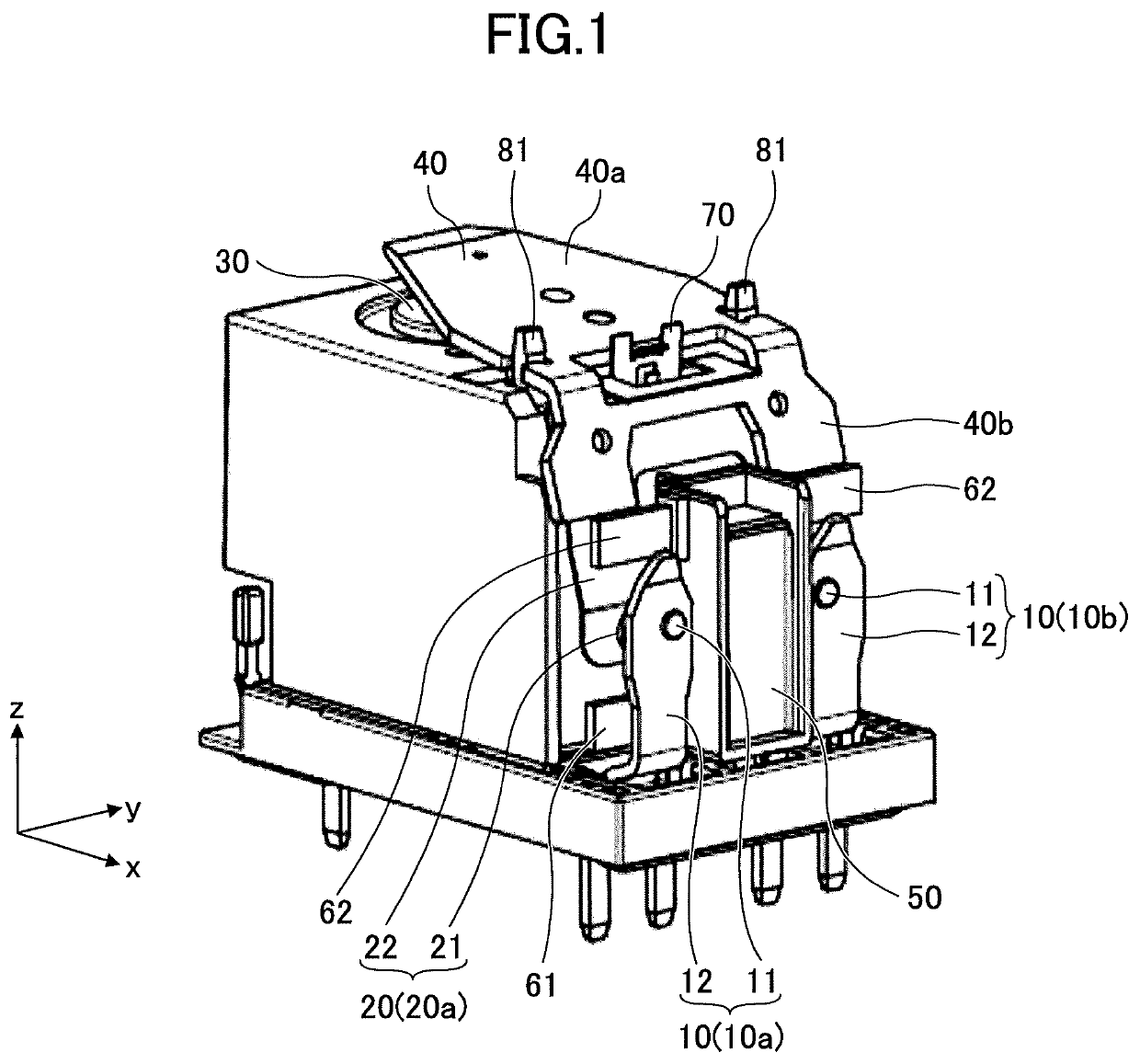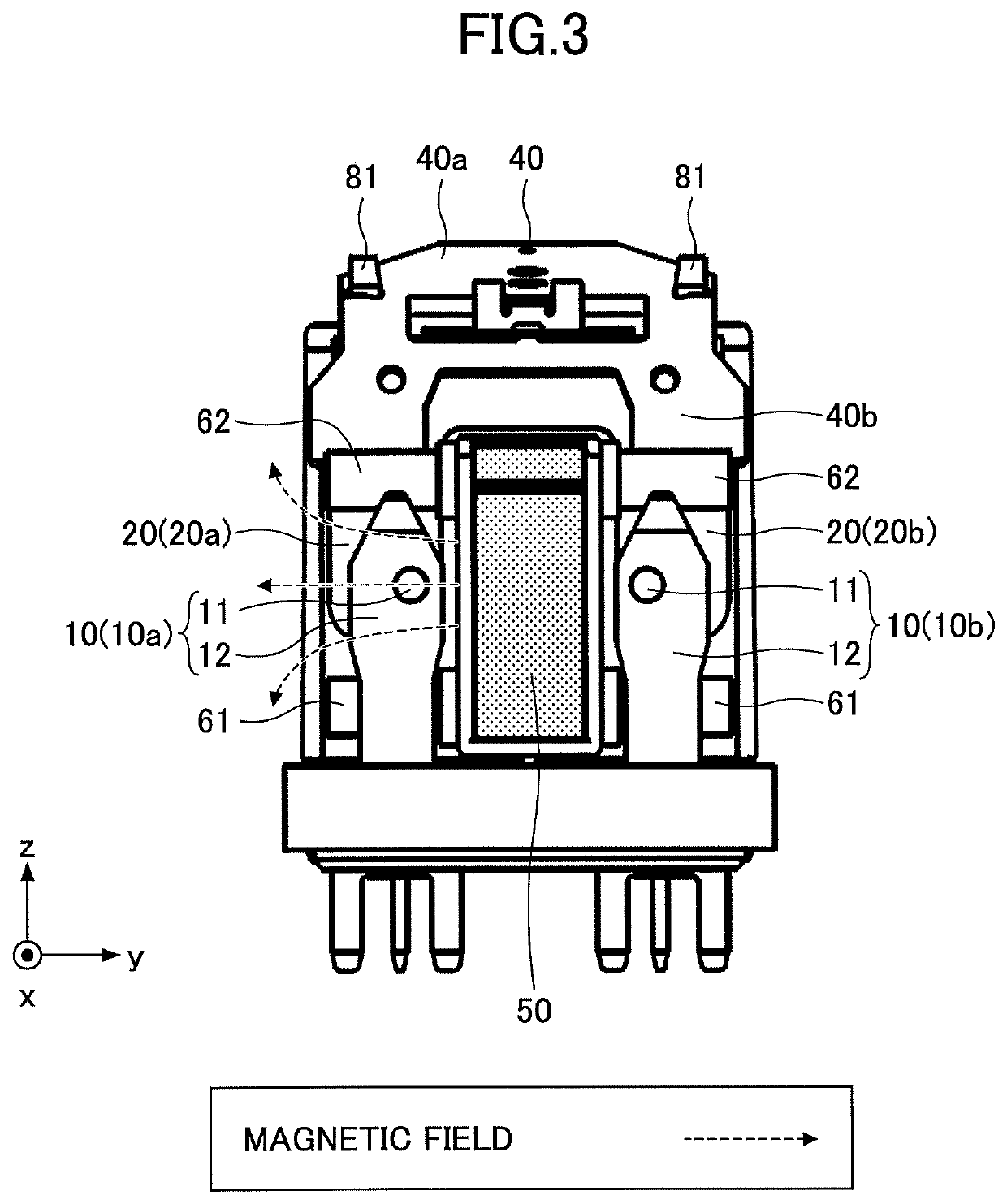Electromagnetic relay
- Summary
- Abstract
- Description
- Claims
- Application Information
AI Technical Summary
Benefits of technology
Problems solved by technology
Method used
Image
Examples
first embodiment
[0033]An electromagnetic relay (hereinafter referred to as “relay”) according to a first embodiment is described with reference to FIGS. 1 through 3. The relay of the first embodiment includes a fixed contact part 10 including a fixed contact 11 and a fixed terminal 12, and a movable contact part 20 including a movable contact 21 and a movable spring 22. In the first embodiment, the relay includes two pairs of the fixed contact part 10 and the movable contact part 20. In the descriptions below, one of the two pairs including a fixed contact part 10a and a movable contact part 20a is referred to as a first contact pair, and the other one of the two pairs including a fixed contact part 10b and a movable contact part 20b is referred to as a second contact pair.
[0034]An electromagnet 30 is provided on the side of the relay where the movable contact parts 20 are provided. An armature 40 is provided near an end of the electromagnet 30. The armature 40 is bent into a shape like an inverted...
second embodiment
[0058]Next, a second embodiment is described. As illustrated in FIGS. 18 and 19, a relay of the second embodiment includes a permanent magnet 150 that is long in z direction. For example, as illustrated in FIG. 20, if a permanent magnet 51 that is short in the z direction is used, a generated arc is stretched toward the permanent magnet 51 as indicated by a dashed double-dotted arrow and may damage the movable spring 22 and the armature 40 near the permanent magnet 51.
[0059]In the second embodiment, the permanent magnet 150 that is long in z direction is used, and the fixed contact 11 and the movable contact 21 are disposed in positions that are shifted in −z direction from the center of the permanent magnet 150 in the longitudinal direction. With this configuration, as indicated by a dashed double-dotted arrow in FIG. 19, a generated arc is first stretched in a direction away from the permanent magnet 150 and contacts the second arc extinguishing plate 62 at a position away from th...
third embodiment
[0065]Next, a third embodiment is described. In the embodiment, an armature is formed of a magnetic material with high permeability and has a certain thickness to provide strength.
[0066]As indicated by an arrow A in FIG. 22, the magnetic flux from the permanent magnet 150 passes through the second side 40b of the armature 40. Therefore, the magnetic field is weakened in an area higher than the fixed contact 11 and the movable contact 21 in +z direction, and the effect of the magnetic field to stretch the arc may be reduced.
[0067]When the movable contact 21 moves away from the fixed contact 11, the second side 40b of the armature 40 contacts a backstop 93 formed on the insulation case 90 while the restoring force of the spring 70 is maintained to position the movable contact 21 attached to the movable spring 22 and to suppress the return bounce of the movable contact 21.
[0068]The second side 40b of the armature 40 that is thicker than the movable spring 22 and has a greater thermal c...
PUM
 Login to View More
Login to View More Abstract
Description
Claims
Application Information
 Login to View More
Login to View More - R&D
- Intellectual Property
- Life Sciences
- Materials
- Tech Scout
- Unparalleled Data Quality
- Higher Quality Content
- 60% Fewer Hallucinations
Browse by: Latest US Patents, China's latest patents, Technical Efficacy Thesaurus, Application Domain, Technology Topic, Popular Technical Reports.
© 2025 PatSnap. All rights reserved.Legal|Privacy policy|Modern Slavery Act Transparency Statement|Sitemap|About US| Contact US: help@patsnap.com



